|
So You Want Your Own Cuttlefish Army?
by Daniel Pon (Paradox009)
Like many of you, my attraction to having my own piece of the ocean started young and has evolved from fresh water tanks to full blown reefs. In addition to this, I’ve always had a strong interest in the bizarre and exotic which started my obsessive journey with Cephalopods 15 years ago. Some of my experiences have been documented on my amateur web site and dubbed The Cuttlefarm Army. Although I was thoroughly entertained with keeping octopuses, the elusive cuttlefish was always on my mind. I'd stare in amazement in the public aquarium, coveting this octopus-like hover craft, shooting out its two feeder tentacles to capture their prey all while flashing brilliant colors! Availability for hobbyists was nearly non-existent at this time. My search continued until Octopets (now closed), a Los Angeles-based company offering cephalopods began selling a species called Sepia Officinalis. This species turned out to be very challenging to keep, being cold water and reaching sizes of one and a half feet! However, the experience of keeping one just furthered my need for more!
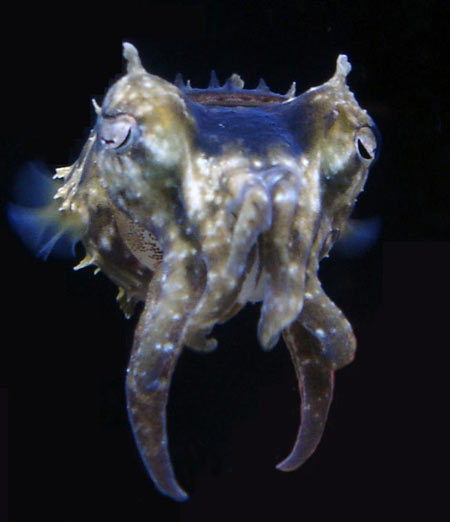 |
Sepia bandensis - Adult |
Researching for a more aquarium-friendly cuttlefish, I found what seemed to be the perfect species. Sepia bandensis or more commonly known as the Dwarf Cuttlefish. Full grown at 4-4.5 inches, this species lives in 75-80 degrees! In 2005, my search ironically lead me to Richard Ross of DaisyHillcuttlefarm.com, a fellow cephalopod enthusiast living 20 minutes away. He recently was able to obtain eggs, and from him I acquired my first clutch and embarked on my journey to learn how to successfully keep and breed this species.
At this time, there was very little reliable information regarding raising this species, let alone breeding. Invaluable sources and support came mainly from Richard Ross and Tonmo (The Octopus News Magazine Online), a great community and information center for all things related to Cephalopods. We had to experiment greatly with appropriate diets at different life stages. A lot of disinformation probably carried over from octopus care needed to be challenged such as keeping them in groups or under bright lights like in a reef system. Three years later and going through three full groups of Bandensis raised from eggs to their full life expectancy, I was finally able to successfully breed them. I was very proud of this success, for at this time the number of successful breeding attempts recorded in the US can be counted on one hand... with maybe a finger left over!
With the collected efforts of Tonmo and other enthusiasts, keeping cuttlefish in the home aquaria is more available and understood.
What exactly is a cuttlefish?
Cuttlefish (not cuddle fish) are classified in the phylum Mollusca, Class Cephalopoda, in the order Sepioidea. They have ten tentacles, eight of which have muscular suction cups and two that are longer and can shoot out to grasp their prey. They have an internal shell embedded in the mantle. With certain species of cuttlefish, this bone is commonly used as calcium or lime supplements for pet birds. They swim via jet propulsion by forcibly expelling water through a siphon while lateral fins are used as stabilizers and for steering. When disturbed, a cuttlefish can eject a cloud of dark ink from an ink sack and like other cephalopods, the cuttlefish is capable of amazing color and skin textural changes. Their color changing is not fully understood, but can be used for camouflage, communication or hypnotizing their prey!
Sepia bandensis
This article will focus on Sepia bandensis, commonly called Dwarf or Stumpy Spined Cuttlefish that are commonly found in the tropical Indo-Pacific regions over coral reefs and sand. Bandensis and a couple other species are often observed walking on two tentacles. In the home aquaria, they have been successfully kept in cuttlefish-only or reef environments.
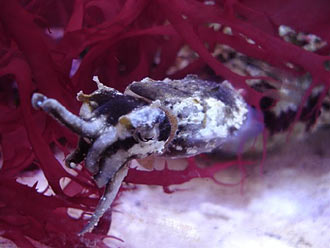 |
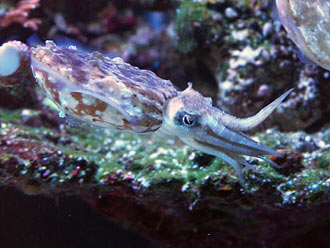 |
| Sepia bandensis - Resting in macro algae |
Sepia bandensis - About to strike |
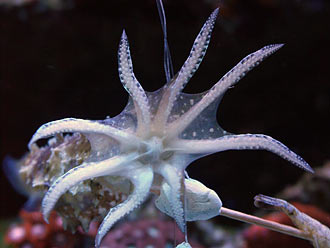 |
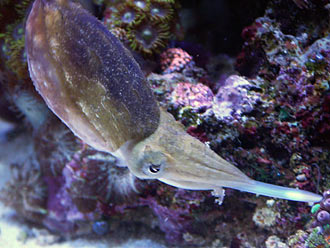 |
| Sepia bandensis - From the perspective of its prey |
Sepia bandensis – Striking with feeder tentacles |
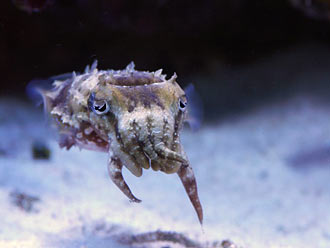 |
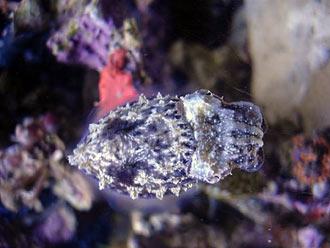 |
| Sepia bandensis - Walking |
Sepia bandensis – Top View |
Their eggs are black (injected with ink) and are approximately ¾” in diameter. Newborns are ¼” in size and have reached 4.5” in captivity. Like most cephalopods, their lifespan is short -- averaging a little over a year in a well-kept aquarium.
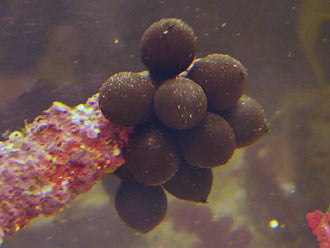 |
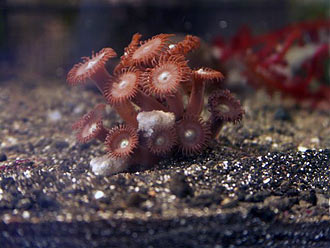 |
| Sepia bandensis - Egg Cluster |
Size comparison - New Born Captive Bred Bandensis with small zoanthids |
Unlike the octopus, Sepia bandensis can be kept in groups which make them even more attractive as a pet. In fact, I would recommend against keeping them as a solo inhabitant just because you will find them inactive and boring! Bandensis seem to be very social animals, constantly interacting with each other. An even amount of males and females is preferred to give you the fullest experience, allowing you to observe mating and male displays. Too many males however may lead to excessive fighting and in some cases, death.
Do you have what it takes?
Keeping a cuttlefish should be considered by diligent and advanced aquarists. Although the requirements may not be exactly the same, similar equipment, water quality and husbandry is reflected in reef keeping. So if you are successful in reef keeping, you should do well with cuttlefish. This by no means limits cuttlefish to reef keepers, but be aware of the amount of time, research, and costs involved before diving in.
Cuttlefish are very lively and intelligent which often creates an emotional bond with its keepers. They are short lived, so be prepared for this loss at around one year of age. Ideally, I would like to see keepers develop a self-sustaining system designed to breed their own cuttlefish. This way, as your adult cuttlefish are reaching senescence, you will already have your next generation of cuttlefish growing in a nursery tank.
Where do I get a Cuttlefish?
As you may have guessed, cuttlefish are not easy to find. There are no species of cuttlefish that live in local waters and they do not fare well being shipped around the world. There are three scenarios that involve acquiring a cuttlefish.
 Wild caught: If the rare occasion that a wild caught specimen does make it across the pond, there are many reasons in which it is a bad idea to buy it. In most likelihood, it is an adult and with such a short lifespan, you may have purchased an expensive pet that only has a few months left to live. If it’s just a single specimen, as mentioned earlier, your experience with keeping it may be very limited or even boring. Most significantly, avoiding this purchase will not contribute to lessening their numbers in the wild. Wild caught: If the rare occasion that a wild caught specimen does make it across the pond, there are many reasons in which it is a bad idea to buy it. In most likelihood, it is an adult and with such a short lifespan, you may have purchased an expensive pet that only has a few months left to live. If it’s just a single specimen, as mentioned earlier, your experience with keeping it may be very limited or even boring. Most significantly, avoiding this purchase will not contribute to lessening their numbers in the wild.
 Captive Bred/raised: There is a growing number of enthusiasts that are trying their hand at breeding, resulting in offspring available for purchase. This is a great way to acquire a cuttlefish. There are specific needs required in raising cuttlefish at early ages. Purchasing them from a breeder past this milestone age can relieve you of the burden of having to have a nursery or feeding them live foods. Captive Bred/raised: There is a growing number of enthusiasts that are trying their hand at breeding, resulting in offspring available for purchase. This is a great way to acquire a cuttlefish. There are specific needs required in raising cuttlefish at early ages. Purchasing them from a breeder past this milestone age can relieve you of the burden of having to have a nursery or feeding them live foods.
 Eggs, wild caught or laid in captivity: Eggs are a great choice to experience the entire lifespan of your cuttlefish. Eggs are easy to ship, typically cheaper, and a good way to set yourself up with a good breeding stock. This route will require more work and equipment, as cuttlefish in the first couple months will have specific needs. Eggs, wild caught or laid in captivity: Eggs are a great choice to experience the entire lifespan of your cuttlefish. Eggs are easy to ship, typically cheaper, and a good way to set yourself up with a good breeding stock. This route will require more work and equipment, as cuttlefish in the first couple months will have specific needs.
That being said, the best resource to acquire a cuttlefish is Tonmo.com. You will also find a wealth of knowledge from a community of experts and hobbyists.
Parameters, Equipment, and Requirements
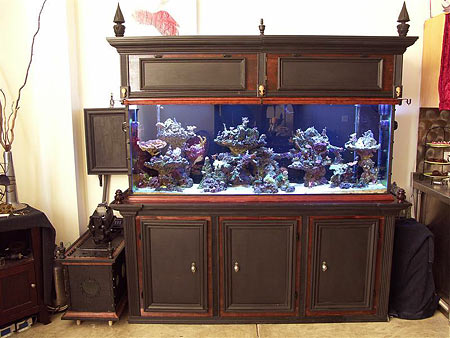 |
150-gallon Cuttlefish Reef and Breeding System |
Tank size: Tank size is important to control excessive male aggression or a constant pacing behavior that can lead to skin injuries on the front tentacles (reported by Richard Ross in 2008). Below is an estimate tank size for adult sized cuttlefish. Hatchlings and juveniles can and should be housed in a smaller tank.
Tank Size:
40 gallons
55 gallons
75 gallons
100+ gallons |
|
Number of Adult Bandensis:
1-2
4
6
8+ |
Temperature: 72-80 degrees Fahrenheit. Studies have shown that higher temperatures can lead to shorter life spans due to increased metabolism. The optimal low heat tank design would have all heat creating devices such as the return pump, skimmer, and flow devices plumbed externally on the tank. I also recommend Ecotech’s Vortech pumps because of their ingenious design that keeps the motor and electricals out of the water. Fewer pumps in the water, the lower your constant temperature will be. This can save electricity if you do not need a chiller to keep the cuttlefish cool.
Copper: 0 ppm. Copper or any heavy metals are lethal to cephalopods, so be wary of using old tanks that were once medicated.
Salinity: 1.026 specific gravity, pH 8.1 to 8.4, Ammonia, Nitrite, and Nitrates as close to 0 as possible.
Tank maturity: It is recommended that the tank should be as mature as possible, having completed the initially Nitrogen cycle long ago. Be prepared for a large bio-load for they are ferocious and messy eaters. Having a matured tank requires that you to set up a tank and have it develop even though you do not have a cuttlefish yet. You may get bored with an empty tank, but this will avoid unnecessary deaths and frustration.
Substrate: Shallow sand beds are advised for they will enjoy digging or burying themselves from time to time.
Aquascaping: Light to medium amounts of live rock is advised. If using high light and/or high flow, be sure to add caves and platforms that allow variation. Too much live rock may make it more difficult to observe your pet .
Flow: Bandensis have been shown to tolerate high levels of flow, but this is not a requirement. If high flow is used, be sure there are spots of lesser flow for them to relax. This can be created by rock structures and caves. Securely cover the intakes of any pumps or powerheads to avoid injury or death.
Lighting: I have kept Bandensis at many different levels of lighting from an incandescent house bulb to full metal halides. I observed no change in behavior in each of these settings. There have been second hand reports of certain species of cuttlefish going blind due to intense lighting, but I’ve never observed this myself nor found a reliable source to confirm it. Lighting is more appropriately chosen to sustain corals if you choose to keep them in the same tank.
Filtration: Protein skimmers are essential for these high-waste producing pets. Oversized is always better. A lot of bio filtration via live rock is also good for ammonia removal. Bio balls or bio-bale may be helpful for ammonia production, but constant cleaning is necessary to prevent nitrate buildup. I have found that sufficient live rock in an established tank will be sufficient. If you do have problems with nitrates and have tried all options of removing its source, then nitrate removers such as remote sand beds, refugiums, sulfur reactors, or carbon dosing can be utilized.
RO/DI (Reverse Osmosis/De-ionization): To ensure optimum water conditions, a RO/DI unit is advised unless you happen to live in an area with low TDS (total dissolved solids) water. This will also aid topping off water evaporation from your tank.
Carbon: Carbon is not necessary, but can help polish the water for clarity. Some cephalopod owners have a mechanical filter or a phosban reactor filled with carbon on standby in case of inking incidences. However, with Sepia bandensis, inking is not a big problem.
Tank Mates
Cuttlefish are very adept hunters and can take down prey three-to-four times their size. This makes tank mates very limited. It is not recommend to keep fish with your Bandensis. Fish, especially thin and slender ones like wrasses are instant meals while larger fish may co-exist for a while, but can easily be made into a meal down the road. Other animals to avoid are shrimp and crabs (except hermits), for they are favorite delicacies of the cuttlefish.
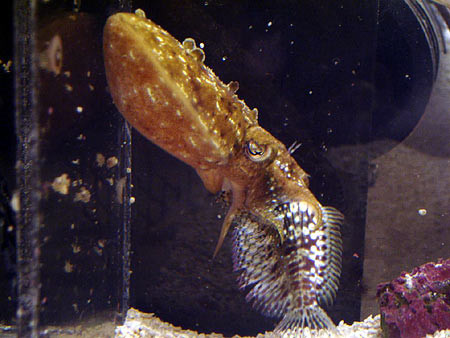 |
Sepia bandensis - 4 month old eating a Lawnmower Blenny |
Suitable tankmates are starfish, non-sharp spined urchins and non-stinging corals. I have had success with keeping Bandensis in a full blown SPS reef with the majority of corals being SPS or softies. Since LPS are mostly stinging corals, it is not advised to have many of these. A cuttlefish will natural avoid a stinging-type coral, so if you choose to have these, be sure that it is only a couple specimens in a large tank. Anenomies would be advised against. Clean up crews can consist of snails, hermits, serpent stars and bristle worms.
Something to keep in mind before putting cuttlefish in the tank is to ensure that your rocks are pest free. Many pests such as aptasia or bubble algae that plague aquarists may be controlled by biological predators (example:. Peppermint shrimp for aiptasia or Foxface fish for bubble algae). These predators unfortunately are meals for cuttlefish. Adding cuttlefish to an existing tank with these pests can rule out the use of these natural predators and leave you manually battling them through physical or chemical removal, which for the most part is unsuccessful. So from firsthand experience, these issues should be resolved before introducing your cuttlefish.
The Nursery and Food Tank
If you are choosing to raise cuttlefish from eggs or want to attempt breeding, you will need a smaller section or tank devoted for babies and juveniles. The most efficient way of doing this is to plumb in a small tank or container in-line with your main system. This way, it can share the same equipment, which should keep its water quality stable and will not require any additional maintenance. We will call this section the nursery. The nursery should have some sand or miracle mud and a small amount of macro algae.
For eggs and hatchlings, they should be held in a breeder net, which can be custom-made (if you are handy), or easily found at your local fish store. This breeder net should hang inside the nursery and should be accessible and viewable. A single breeder net can be used to hold clutches of eggs or up to six hatchlings. Keeping eggs and hatchlings separate will help you observe the newborns eating behavior. Be sure that whatever you use, that there are enough holes for circulation, but not big enough for baby Bandensis or their food to escape. Having a few breeder nets handy is a good idea, in case you need to isolate finicky eaters or to swap them out for cleaning. After a month or two, the cuttlefish can be taken out of the breeder net and released into the nursery.
If you choose to keep your own live shrimp, you will need to have a method to keep them alive. Plumbing a small tank to the main system like the nursery will require the least maintenance. Even better is to create an all-in-one nursery/live food tank instead of two separate ones. This can be a tank that is divided into two sections where water flows from one to the other. It is very important to ensure that the inhabitants between the two sections cannot see each other. A cuttlefish will consistently strike at the glass if it sees food on the other side, which can lead to injury. Ideally, water should flow from the main tank via gravity or mechanical means into the nursery and then to the live food section and back to the tank or sump. Be sure that young cuttlefish cannot accidentally travel from one chamber to the next. I prefer the use gutter guard mesh material (found at local hardware stores) to safeguard against any areas that cuttlefish could escape through.
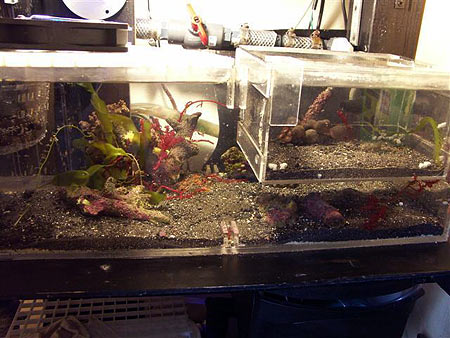 |
The Nursery - Hand-made 4-gallon tank that can be divided into sections
to house live foods or baby cuttlefish differing in size |
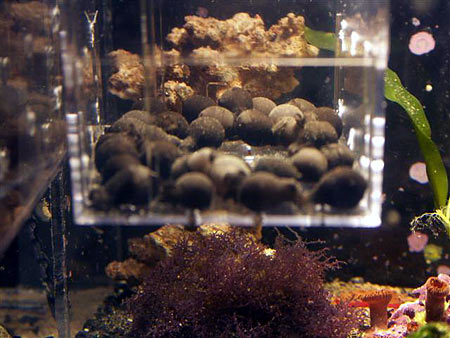 |
Egg container in the nursery |
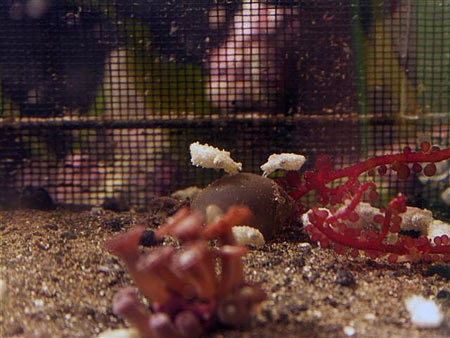 |
Captive bred newborn Bandensis - Held in a custom-made breeder hanging in the nursery. |
What to Feed and When
The past few years required a lot of experimenting to understand how to successfully raise Bandensis. The most difficult question to answer was what to feed them at what stage of their life. Cuttlefish grow at an incredible rate, with visual differences per week if not daily when they are young. Having the right-sized foods for the right stage is vital to achieve a healthy specimen. For a while it was thought that only live food could be used, which was so expensive! The cost of food alone discouraged anyone except the truly-obsessed to attempt to raise them. Luckily for you, I’ve learned how to train Bandensis to take frozen foods between the ages of 30 to 45 days. I will describe and outline each stage of feeding below.
0 - 1.5 months:
If you chose the hardcore route of raising cuttlefish from an egg, you will meet your greatest challenge right away. A new born hatchling is a quarter of an inch long and will only take live foods. A newborn may not eat for up to two weeks depending on how much of a yolk sac it has left. The best food of choice for cuttlefish this young is live mysids. There are a few online sources to acquire these if you cannot get them locally. With shipping they are pricey, but this is only necessary until we train them to eat frozen. You will want to feed about 2 shrimp a day. Try not to flood feed them for this can intimidate the babies. Place the same amount of shrimp as you have cuttlefish at one time. This way you can observe and ensure each one is eating. Some will be less effective hunters and may need to be separated.
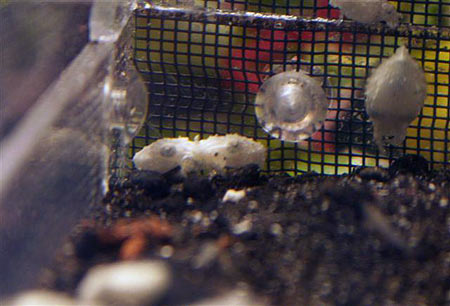 |
Two Captive bred Bandensis eating the same mysis shrimp |
At one month, you will want to start training them to eat frozen. If you had any of your live mysids die off, try to net them up and freeze them immediately for they would be perfect to use at this time. At feeding time, throw some thawed mysids mixed with live ones in with the baby cuttlefish. There should be some gentle flow in the breeder net or nursery. This will help keep the thawed mysids in motion which will attract the attention of the cuttlefish. After a while, try offering only thawed shrimp in at feeding time. If they are still uninterested in thawed shrimp I have used a stick to maneuver the food in front of the cuttlefish. Then tap at the shrimp so it looks like it is alive. Keeping the backside of the shrimp facing the head of the cuttlefish helps for this is where they feel safest to strike. Some cuttlefish are willing to eat frozen rather readily, while others will require daily attempts until they finally decide that thawed shrimp are food after all. If they do not eat the thawed shrimp one day, give them live shrimp and try again tomorrow.
I would suggest PE mysids as a good frozen product. However, these are typically larger than the live mysids from online sources, so freezing the live mysids that have died is a good idea for they will not be as intimidated by the size during frozen food training. Although successful weaning them onto to frozen shrimp is an economic milestone, giving them live foods once in a while is good idea to maintain a varied diet.
1.5 - 3 months:
At this age, they can reach half an inch to one inch in size and mysids are becoming too small to be a food source unless you are feeding four-to-five daily to each individual. The perfect live food at this stage are Palaemontes Vulgaris which are marine shrimp that are similar in size and appearance as the freshwater Ghost Shrimps. You will notice a growth spurt once you change to this larger shrimp. These can be bought live online but again, can be costly. I have asked the same online resources to sell me their dead shrimps frozen and have found them to be willing to accommodate. Frozen krill can also be used at this time as well but seems to be the least favorite of all the shrimp alternatives.
3 months and on:
At around three months, your cuttlefish can be 1.5 inches or larger and ready to not just graduate to a larger food, but to be released into the main tank as well. At this age, a new technique can be introduced with feeding. If your main tank is filled with rocks and stronger flow, the last thing we want is uneaten shrimp that goes unnoticed and falls behind a rock to pollute the water. To protect from this, I have made a feeding device that skewers the shrimp and allows the cuttlefish to eat directly off of them! If you have an open (less rockwork) lower-flow tank, food can be thrown directly into the tank into the line of sight of the cuttlefish.
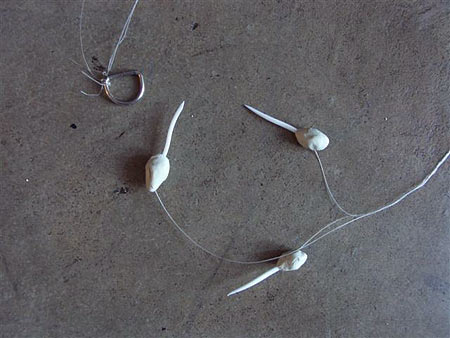 |
Feeding Skewers - Made from fishing line, Aquamend epoxy, and plastic dental picks |
These are easily made with fishing line, Aquamend (2 part epoxy), a metal ring, and plastic dental floss picks. I purchased everything from a local hardware store and found the plastic dental floss picks at a grocery store. To make them, cut the plastic handle off the picks and encase the end of the fishing line and plastic handle with a small amount of aquamend. Once dried, the fishing line will be solidly attached to the plastic handle and act as a weight to prevent it from floating around in the tank. Make as many of these as you have cuttlefish and then tie them to the metal ring. On my tank, I placed a hook on the outside of my tank to hang the skewers from the metal ring preventing it from falling or being pulled into the tank.
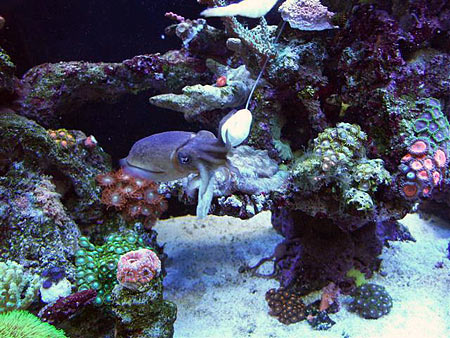 |
Adult Bandensis - Eating shrimp from a skewer |
Again, a larger size food will be needed as an appropriate source of nutrition. I discovered that the best choice to be found is not at a fish store, but at my local bait shop. Live or frozen Grass shrimp are sold by the pound for very little! If you do not live near a bait shop, there are a few online that are willing to ship. To mix things up, you can also try frozen silversides sold at most fish stores. These two food choices are large enough to be used as their main food until the end of their life cycle.
If you are going to use the skewers, get your cuttlefish familiar with them in the nursery prior to introducing the cuttlefish to the main tank. Impale the shrimp or silverside with the plastic skewer and place them in with the cuttlefish. Once they seem to be confident with this new feeding technique in the nursery, feel free to release your cuttlefish into the main display! Expect them to be shy at first, but slowly getting more comfortable as they get used to their new environment. You may need to move the feeding skewers around to ensure they can see it during feeding, but they will soon learn the routine quickly. In no time, they will all be up front by the glass, every time they see you near the tank!
Alternative foods can include small crabs (with their pinchers removed if they are large), and small saltwater feeder fish. Do not feed with fresh water feeders such as goldfish for they are often treated with copper-based medicines and will poison your cuttlefish! Freshwater shrimp, such as ghost shrimp, can be used and have been found to be similar in nutritional value as marine shrimp, but should not be used as a primary source of food.
Sexing and Breeding
It is very difficult to determine the sex of Bandensis accurately. Behavior and displays will give clues starting as early as three months of age. Males will begin to display contrasting black and white colors to other males as a sign of aggression or territorialism. Females will have less drastic changes and seem to mostly maintain their resting patterns the majority of the time. However, males may mimic female displays and vice versa, so the only certain method is to observe actual breeding.
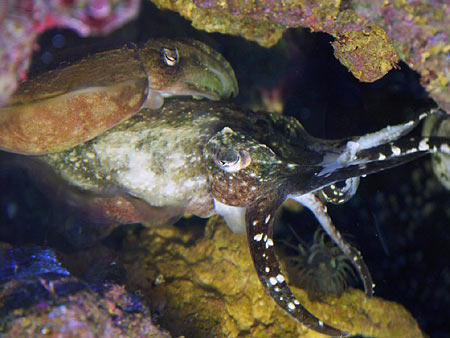 |
Adult male Bandensis – Male aggressive displays warning other males to stay away from the female (top) and eggs deep in the cave. |
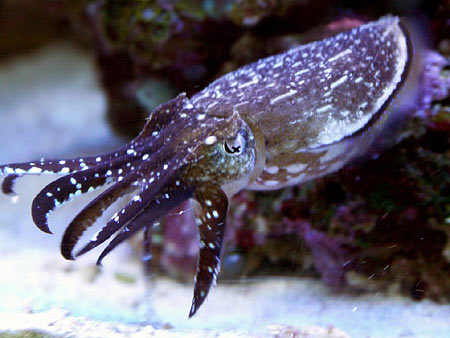 |
Sepia bandensis - Adult Male display of aggression |
Getting your cuttlefish to mate will not be difficult. Actually, you should start seeing mating occur at three to four months of age. The difficult part is acquiring viable eggs. Viable eggs will begin to inflate and get larger while a visible embryo will develop and even move inside the egg. A viable egg may take two weeks to a month to hatch. If they are laid in the main tank, wait a week or so before removing them and place them in a breeder net. The utmost care should be used when handling them for if they are disturbed too much, premature hatching will occur. Premature births will typically lead to death. If the egg is a dud, it will soon deflate and begin to deteriorate.
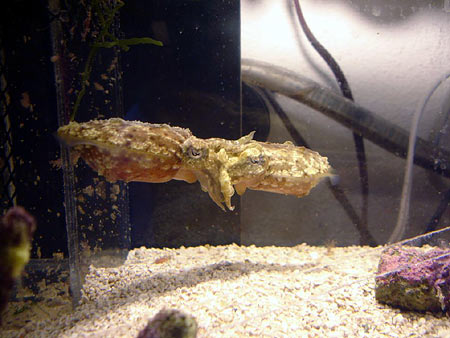 |
Four month old Bandensis – Mating with the male on the left. |
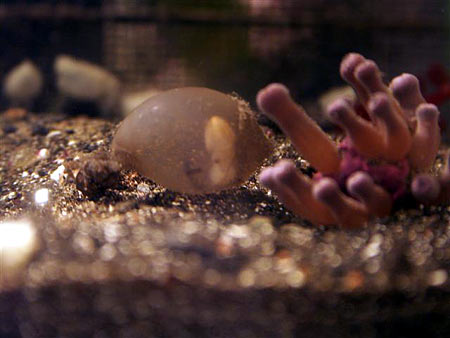 |
Captive bred Sepia bandensis egg - The egg is expanding and the embryo with yolk sac is clearly visible |
There are many factors that effect reproductive success. Without scientific studies in a controlled environment, we are left, more or less, guessing with only our own experiences and reports. Several factors have changed when comparing my previous failed attempts to my recent success. The most significant differences is a much more sophisticated system producing improved water quality (specifically nitrates) and the type of diet used.
In previous breeding attempts, the main diet was small shore crabs caught locally. Although this was cheap, the adult size of these specimens only reached an average of 3 -3.5 inches. Now with larger shore shrimps as the main adult food, they are growing larger and seem healthier overall.
Studies have shown octopuses to be tolerant of higher nitrates, but reproduction can be affected after 100 ppm. This may very well carry over to cuttlefish for my current system has kept nitrates very low or undetectable. In comparison, all my previous and failed attempts to breeding involved a higher nitrate environment. My recommendation is to keep this figure as low as possible, not only for the possible benefits to reproductive health, but to minimize the development of any nuisance algae.
Age will also play a role in viability of eggs. First batches of eggs may appear at around four months old and will only have a small percentage turn out to be viable. The percentage will grow as the cuttlefish mature and begin to drop down again as they reach the end of their life cycles. A single mated pair can lay well over 200 heads in one lifetime. With these numbers, it would be nice to see hobbyists flooding the market with captive bred Bandensis and removing the need to pluck them out of their natural environments ever again!
Conclusion
My goal for this article is to make Sepia bandensis more readily available to the domestic market by helping enthusiasts successfully keep and breed them. I would encourage you to join the Tonmo.com community for further insight, support and the ability to chronicle your experiences with animals. Your experiences are vital to the continued development and understanding of these creatures.
Acknowledgements
I would like to thank Richard Ross and the online communities of Tonmo.com and Reef Central for their wealth of knowledge and support.
Resources and Live Foods:
The CuttleFarm Army
Richard Ross
The Octopus News Magazine Online
Mysids
Palaemontes Vulgaris
If you have any questions about this article, please visit my
discussion thread
on Reef Central.
|

